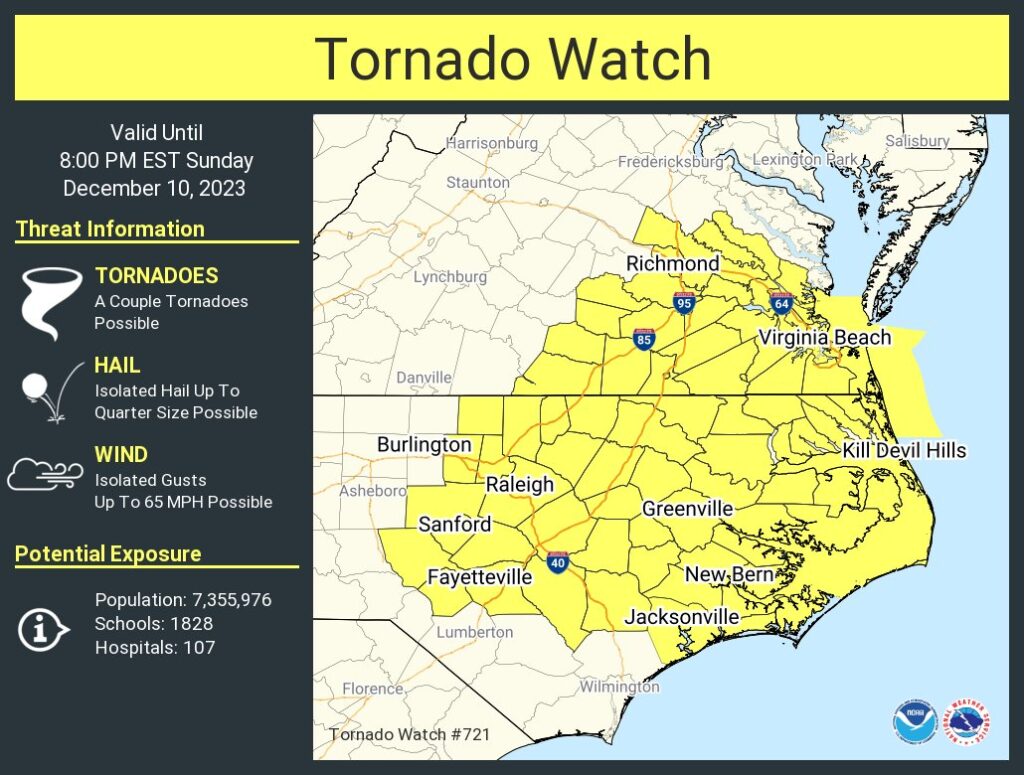A tornado watch issued for Northern New York is a critical alert that demands attention and preparation. This weather advisory indicates that conditions are favorable for tornadoes to develop, and it’s essential for residents to stay informed and ready. This article will explain what a tornado watch is, why it has been issued for Northern New York, and how you can stay safe during such alerts.
Understanding a Tornado Watch
When a tornado watch is issued, it means that the weather conditions in the area are conducive to tornado formation. Unlike a tornado warning, which indicates that a tornado has been sighted or detected by radar, a tornado watch serves as an early alert. It’s a signal for residents to be prepared and to monitor weather updates closely.
Key Characteristics of a Tornado Watch
- Conditions Favorable for Tornadoes: A tornado watch is issued when meteorologists predict conditions that could lead to the development of tornadoes. This could include severe thunderstorms, high winds, and other atmospheric factors.
- Not a Guarantee: It’s important to note that a tornado watch does not guarantee that a tornado will occur. It simply means that the potential exists.
- Duration: Tornado watches are typically issued for several hours, but the exact duration can vary depending on the weather conditions and forecasts.
Why a Tornado Watch is Issued for Northern New York
Northern New York, known for its diverse weather patterns, can occasionally experience severe storms and tornadoes. Several factors can contribute to the issuance of a tornado watch in this region:
Meteorological Conditions
- Severe Thunderstorms: Severe thunderstorms can produce tornadoes. When these storms are expected to develop in Northern New York, meteorologists may issue a tornado watch.
- Atmospheric Instability: Warm, moist air interacting with cooler, dry air can create instability in the atmosphere, making tornadoes more likely.
- Wind Shear: Changes in wind speed and direction with altitude, known as wind shear, can contribute to tornado formation.
Geographic and Seasonal Factors
- Geographic Location: Northern New York’s geographical location means it can occasionally experience weather patterns similar to those found in tornado-prone areas.
- Seasonal Trends: Tornadoes are more common during certain seasons, especially in spring and summer. However, they can occur at any time of year, depending on weather conditions.
How to Prepare for a Tornado Watch
Preparation is crucial when a tornado watch is issued. Here are some steps you can take to ensure your safety:
Stay Informed
- Weather Updates: Keep a close eye on local weather updates from reliable sources such as the National Weather Service (NWS) or local news stations. Weather apps and radio broadcasts can also provide timely information.
- Emergency Alerts: Sign up for emergency alerts through your local government or weather service to receive updates and warnings directly.
Create a Safety Plan
- Identify Safe Locations: Determine where you and your family can go to stay safe during severe weather. The safest places are usually interior rooms on the lowest level of your home, away from windows.
- Emergency Kit: Prepare an emergency kit with essential supplies such as non-perishable food, water, medications, a flashlight, batteries, and a first aid kit.
Secure Your Property
- Check for Hazards: Inspect your property for any items that could become projectiles in high winds, such as loose branches or outdoor furniture. Secure or move these items to reduce potential damage.
- Reinforce Your Home: If possible, reinforce your home’s structural elements to better withstand severe weather. This includes securing roof shingles and windows.
What to Do During a Tornado Watch

During a tornado watch, it’s important to stay vigilant and ready. Here’s what you should do:
Monitor Weather Conditions
- Stay Updated: Continuously monitor weather reports and updates. Tornado watches can quickly change to tornado warnings if conditions worsen.
- Listen for Alerts: Pay attention to weather radios, smartphones, or other devices that provide real-time alerts and warnings.
Prepare to Act
- Review Your Plan: Review your safety plan and ensure everyone in your household knows what to do if a tornado warning is issued.
- Ready Your Emergency Kit: Have your emergency kit ready and easily accessible. This will help you act quickly if you need to move to a safe location.
What to Do If a Tornado Warning is Issued
If a tornado warning is issued, it means that a tornado has been sighted or detected by radar. Here’s how to respond:
Seek Shelter Immediately
- Go to a Safe Room: Move to the pre-designated safe area of your home. If you don’t have a basement, seek shelter in an interior room on the lowest floor.
- Protect Yourself: Use heavy furniture, mattresses, or blankets to protect yourself from flying debris. Cover your head and neck to reduce the risk of injury.
Stay Safe Until the All-Clear
- Avoid Windows: Stay away from windows and doors to avoid injury from shattered glass or flying debris.
- Wait for Confirmation: Remain in your safe area until local authorities or weather services confirm that the danger has passed and it is safe to emerge.
After the Tornado Watch
Once the tornado watch is lifted or a tornado warning has ended, take the following steps:
Assess Your Surroundings
- Check for Damage: Carefully assess your property for any damage. Be cautious of hazards such as downed power lines or structural damage.
- Stay Informed: Continue to follow local news and weather reports for any additional updates or warnings.
Report and Seek Help
- Contact Authorities: Report any significant damage to local authorities and follow their instructions for safety and recovery.
- Seek Assistance: If you need assistance or have been displaced, contact local emergency services or relief organizations for help.
Conclusion
A tornado watch issued for Northern New York is a serious weather alert that requires attention and preparedness. Understanding what a tornado watch means, why it’s issued, and how to respond can help you stay safe during severe weather. By staying informed, preparing in advance, and knowing how to act, you can better protect yourself and your family when tornadoes are a possibility.


